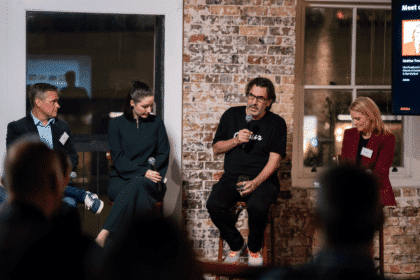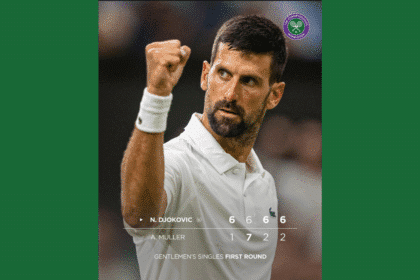The Paris Olympic Games broadcaster took a “leap of faith” by turning a 7×7 metre shoebox overlooking the Eiffel Tower into a cutting edge sports studio that Nine says is an Australia-first.
Nine is using the Paris Olympic Games to not only cover sporting excellence and an Aussie gold rush, but also set new benchmarks in TV broadcasting.
It is the first time an Australian broadcaster has used an extended reality studio, powered by AI technology normally used in gaming, to cover a live sports event.
If all goes well, Nine’s head of creative and innovation at Wide World of Sports Alex Rolls said the technology could revolutionise how Australian TV networks broadcast sports in the future.
“What we’re attempting here in Paris is a huge leap of faith, especially trying it out on a large sporting event,” he said. “That was a challenge because if the broadcast goes wrong, it will be exposed on such a massive scale.”
Nine’s Wide World of Sports team typically broadcast live events – whether it’s the Australian Open or State of Origin – on site, but decided to explore an extended reality set when the International Olympic Committee threw host broadcasters a curveball.
They offered official broadcasters eight demountable “shoeboxes” that were not large enough for a physical studio, but were set in the picturesque Trocadero area of Paris and overlooked the Eiffel Tower.
“We wanted that shot (with the Eiffel Tower backdrop) but knew that 7×7 metres isn’t going to look particularly attractive because it’s going to be very small. So this was a perfect opportunity to use extended reality gaming engines,” said Rolls, who spoke to B&T from Paris.
“As long as the presenters have room to have a coffee table or a desk, the rest of the virtual world lives around them and you can create the illusion of a space the size of a football stadium if you want.”

Rolls first got a taste of AI-enhanced set technology at the National Association of Broadcasters conference four years ago, but only saw it in action during a visit to the BBC studios in Manchester and an English Premier League production in London.
Eighteen months ago, Nine partnered with television graphics and data solutions company ae.live group and TV set designer Jago Design to design, build and test a hybrid physical and virtual studio at a warehouse in the UK.
The only parts of the set that are real are a desk and chairs where the presenters sit, a window, camera equipment and sidewalls about three metres deep.
The rest of the studio – including the floor, roof and graphics displayed on extended side walls – are all virtual reality, generated using the same sort of gaming engine technology that powers video games like Fortnite.
“Where the artistry comes is going between the physical world and the virtual world to make it look seamless so the viewer doesn’t even realise,” added Rolls. “The world’s tricked into thinking that your space is reality, when in fact, it’s not the physical window outside.”
Another trick is that the virtual studio automatically adjusts its lighting when external backlight from the window brightens or dims.

On air talent are ‘the real deal’
One thing that isn’t fake is the talent on set. When Ian Thorpe or Cate Campbell or other guests show up on set, it’s the real deal.
Artificially enhanced sets used in the UK and Europe have sometimes beamed in sports pundits to interact with live studio hosts, a modern take of the hologram technology made famous used in movies like Stars Wars.
Nine took the decision to avoid these gimmicks.
“As much as it’s quite a cool trick to beam someone in, like Star Trek, we much prefer the interaction and chemistry that our presenters have with our stars,” he said.
“One of the major reasons for being in Paris is that we want the athletes when they win medals to sit next to our presenters and tell their story.”
So, what does it cost?
Rolls wouldn’t disclose the financial cost of producing a virtual studio to broadcast the Paris Olympic Games, but said it was similar to the cost of a physical studio, but with benefits that could save Nine money in the long run.
“I worked on the London Olympics and the cost of this will come out to be about the same,” Rolls said.
“Where the savings will come is if we take this technology and use it over and over again in Australia, whether it’s in Sydney, Melbourne or Brisbane. With these 3D graphical worlds and the flick of a switch, we can be in a studio space one minute and then half an hour later be in another studio space.
“The savings will come from no longer having to build physical studios and changing it for each show; it will just be done graphically and the savings opportunity, if we continue down this path, is enormous.”
Although the cost of an individual virtual studio and physical studio is similar, going virtual saves costs – and carbon emissions – in other ways, particularly in travel and accommodation.

For the Paris games, Nine is operating a hybrid production model with crew split between France and Australia.
In Paris, Nine’s on-site production crew includes camera operators and floor managers, while the director, producer, vision switcher and graphics operators are all working from Sydney.
In total, about 150 people will be based in Paris, while a further 300 are working on the games from Sydney.
“The savings have not come around because it’s a virtual set versus an old fashioned physical set, it has come by us using a model where we split the production. We’ve made savings by not flying and accommodating a substantial part of our crew in an expensive city like Paris.”
On the first couple of nights of Nine’s coverage, presenters including Ally Langdon and James Bracey, appear to have adjusted to the unusual surroundings seamlessly. In case of any glitches with the virtual set, the robotic camera is programmed to move into a tightly-framed shot of the hosts so that the show can roll on.
“We went to air on Wednesday night (24 July) and Ally and James did a magnificent job presenting it,” Rolls said.
“If you think about the history of sports broadcasting, it’s always had to be bold and innovative. There might be times that are hairy over the next 17 days, but we’re constantly rehearsing and by the time the opening ceremony runs (Saturday morning at around 3am AEST), I hope that our production team and our presenters are as comfortable as they’ll ever be.
“For all intents and purposes, a lot of people out there watching it probably don’t even realise the transition that we’re making here.”
Rolls, pictured below, hopes it will stay that way, and that it is not just the Australian athletes that are setting gold standards at the Paris Olympics for years to come.









